Balarama
| Balarama | |
|---|---|
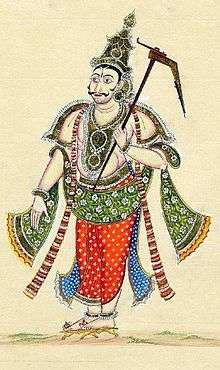 Bala Rama | |
| Devanagari | बलराम |
| Sanskrit transliteration | Balarāma |
| Affiliation | Avatar of Shesha or Vishnu |
| Weapon | Plough |
| Consort | Revati |
| Parents |
Vasudeva(father) Rohini Devi(mother) |
| Siblings |
Krishna (half-brother) Subhadra (half-sister) |
| Part of a series on |
| Vaishnavism |
|---|
 |
|
Sampradayas |
|
Philosophers–acharyas |
|
Related traditions |
|
|
Balarama(Sanskrit: Balarāma), also known as Baladeva, Balabhadra and Halayudha, is the elder brother of Krishna(an avatar of the god Vishnu) and is regarded generally as an avatar of Shesha. He is also sometimes considered as the Sankarshana form of Vishnu and the eighth avatar of Vishnu.
He may have originated in Vedic times as a deity of agriculture and fertility. In Jainism, he is known as Baladeva. He is often depicted with a drinking cup, pitcher, shield and sword.[1]
Early Life

Birth & Origin
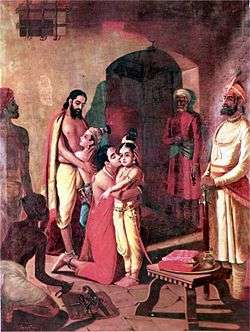
Balarama was son of Vasudeva. The evil king Kansa, the brother of Devaki, was intent upon killing the children of his sister because of a prediction that he would die at the hands of her eighth son.
Vishnu then impregnated the belly of Devaki with two strands of hair, one black, one white. To ensure their safety, their essence was transferred before birth to Rohini, who also desired a child. At birth, Krishna had a darker complexion, while Balarama was born fair. The other name of Balarama is Sankarshana, meaning a spirit transferred between two wombs. According to Bhagavata Purana, the name Sankarshana means, "one who brings together two different families" of King Yadu's and Nanda Baba's dynasties.[2]
He was named Rama, but because of his great strength he was called Balarama, Baladeva, or Balabhadra, meaning Strong Rama. He was born under Shravana nakshatra on Shraavana Purnima or Raksha Bandhan.
Childhood & Marriage
%2C_ca_1585-1590.jpg)
One day, Nanda requested the presence of Sage Gargamuni, his priest, to name the newborn Krishna and Balarama. When the Garga arrived, Nanda, received him well and requested the naming ceremony. Gargamuni then reminded Nanda that Kamsa was looking for the son of Devaki and if he performed the ceremony in opulence, it would come to his attention. Nanda therefore asked Garga to perform the ceremony in secret and Garga did so:
Because Balarama, the son of Rohini, increases the transcendental bliss of others, his name is Rama and because of his extraordinary strength, he is called Baladeva. He attracts the Yadus to follow his instructions and therefore his name is Sankarshana.— Bhagavata Purana, 10.8.12[3]
Balarama spent his childhood as a cow herder with his brother Krishna. He killed Dhenuka, an asura sent by Kansa, as well as Pralamba and Mushtika wrestlers sent by the king. After the evil king died, Balarama and Krishna went to the ashrama of sage Sandipani at Ujjain for study. He later married Revati, daughter of King Kakudmi, ruler of Kushasthali or Anarta[4]
The Kurukshetra War Of Mahabharata
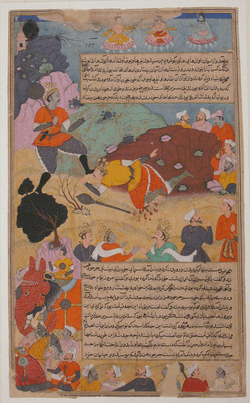
Balarama taught both Duryodhana of the Kauravas and Bhima of the Pandavas the art of fighting with a mace. When war broke between the Kauravas and the Pandavas, Balarama cared for both sides and so remained neutral. When Bhima defeated Duryodhana by striking him in the groin with his mace, Balarama threatened to kill Bhima. This was prevented when Krishna reminded Balarama of the vow of Bhima—to kill Duryodhana by crushing the thigh he had exposed to Bhima's wife Draupadi.[5]
Disappearance
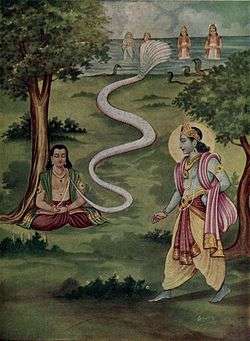
In the Bhagavata Purana, it is described that after Balarama took part in the battle causing the destruction of the remainder of the Yadu dynasty and witnessing the disappearance of Krishna, he sat down in a meditative state and departed from this world.[6]
Some scriptures describe a great white snake that left the mouth of Balarama, in reference to his identity as Ananta-Sesha. The place where he departed is situated near Somnath Temple in Gujarat.
The local people of Veraval believe that in the cave near the temple place, the white snake who came out of Balarama's mouth got into that cave and went back to Paatal Lok.
Status As Avatar
Narratives of Balarama are found in Mahabharata, Harivamsha, Bhagavata Purana and other Puranas. He is classified in the Vyuha avatar Sankarshana where in Adishesha and Lakshmana are part of.[7] Vyasa Mahabharata states that after Balarama's death, he turned in to a white snake and entered the present day Arabian ocean. So it can be concluded that Balarama is an avatar of Aadeshasha in Dwaparayuga, as Lakshmana was in Tretayuga and Patanjali(original practitioner who wrote the first book on Yoga shastra and writer Maha Bhasya to Panini's grammar) in Kaliyuga.
Worship
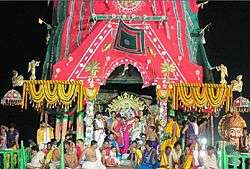
An earlier reference to Balarama is in Kautilya's Arthashastra(13.3)[8]

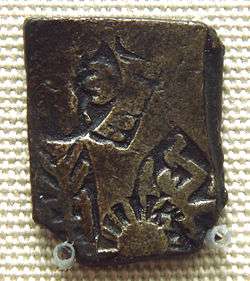

Appearance

Balarama is depicted as fair skinned, in contrast to his brother, Krishna, who is dark skinned, Krishna in Sanskrit means dark. His ayudha or weapons are the plough hala and the gadā. The plough is usually called Balachita.[9] He often wears blue garments and a garland of forest flowers. His hair is tied in a topknot and he has earrings, bracelets and armlets and he is known for his strength.[10]
In Literature
The Jain Puranas, notably, the Triṣaṣṭiśalākāpuruṣacarita of Hemachandra, narrate hagiographical accounts of nine Baladevas or Balabhadras who are believed to be śalākāpuruṣas(literally torch-bearers, great personalities). Balarama was the ninth one.[11]
Harivamsa Purana(8th century CE) also narrates the Jain version of his story.[12]
Temples
Baliyana Mandir, Bainsa(dist Nawanshahr) Punjab
See also
| Wikimedia Commons has media related to Balarama. |
Notes
- ↑ Chandra, Suresh (Aug 15, 2012). Encyclopaedia of Hindu Gods and Goddesses. Kindle Edition. pp. 29–30.
- ↑ Carl Woodham (2011). A God Who Dances: Krishna for You. Torchlight Publishing,. p. 104. ISBN 9780981727363.
- ↑ "Bhagavata Purana 10.8.12". Archived from the original on 12 March 2007.
- ↑ Pargiter, F.E. (1922, reprint 1972). Ancient Indian Historical Tradition, New Delhi: Motilal Banarsidass, p.98
- ↑ Varkey, C.P. (2001). A Pilgrimage Through The Mahabharata. Mumbai: St. Paul Society. pp. 148–149. ISBN 81-7109-497-X.
- ↑ Bhag-P 11.30.26
- ↑ A. C. Bhaktivedanta Swami Prabhupada (1987). Bhaktivedanta Book Trust, ed. Srimad-Bhagavatam: Bhagavata Purana. ISBN 0892132507.
- ↑ Rangarajan, L.N. (1992) (edited, rearranged and translated), Kautilya — The Arthashastra, New Delhi: Penguin, ISBN 0-14-044603-6, p.518
- ↑ Gopal, Madan (1990). K.S. Gautam, ed. India through the ages. Publication Division, Ministry of Information and Broadcasting, Government of India. p. 75.
- ↑ "Appearance of Lord Balaram", Iskondesiretree.com via iskconmanchester.com. Retrieved 2016-09-02.
- ↑ Joshi, Nilakanth Purushottam (1979). Iconography of Balarāma. New Delhi: Abhinav Publications. ISBN 81-7017-107-5., p. 5
- ↑ Upinder Singh 2016, p. 26.
References
- Doniger, Wendy (1993), Purana Perennis: Reciprocity and Transformation in Hindu and Jaina Texts, SUNY Press, ISBN 0-7914-1381-0
- Singh, Upinder (2016), A History of Ancient and Early Medieval India: From the Stone Age to the 12th Century, Pearson Education, ISBN 978-93-325-6996-6


